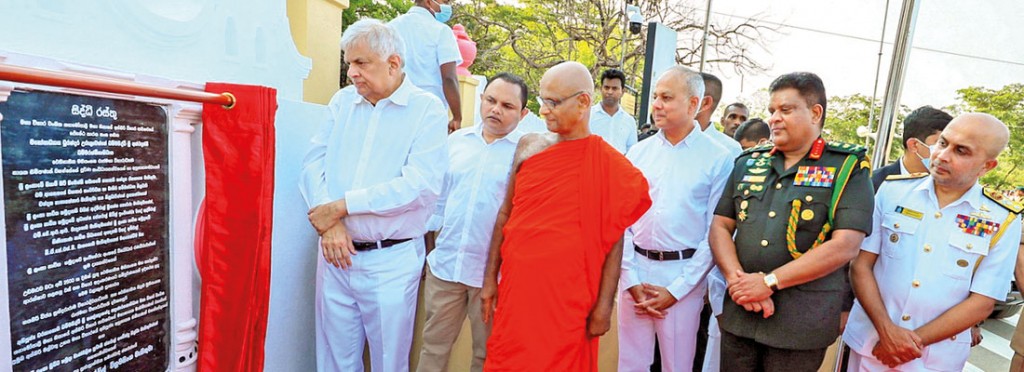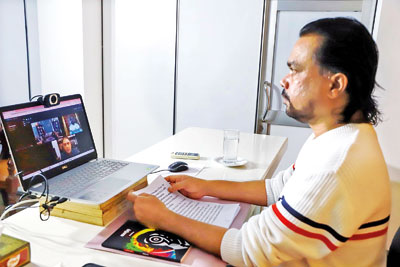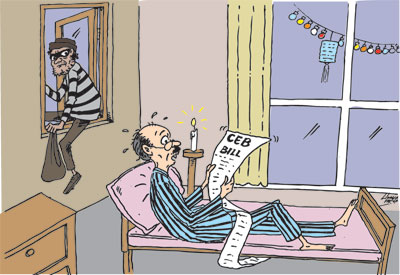Columns
- President’s concept paper gets Cabinet nod; Legal Draftsman to work out draftlegislation in consultation with AG
- Amendment to the CDS Act envisages the establishment of a combined force using industry technology for warfare
- After CDS Shavendra Silva’s letter of demand, Weerawansa vows to reveal more; makes new nexus with anti-US countries
By Our Political Editor
The initiative comes as he embarks on an ambitious “National Transformation” road map announced in an address to the nation on Thursday. That is to be accompanied by a Presidential Delivery Bureau, all part of plans towards further economic resuscitation.
It also coincides with an ongoing controversy on the role of the office of the Chief of Staff (CDS) during last year’s protest (aragalaya ). The Criminal Investigation Department (CID) has begun a fresh probe into their role to ascertain whether there was inaction on their part to quell reported violence.

Chief of Staff Shavendra Silva is seen here with President Ranil Wickremesinghe at the ceremony to declare Mahiyanganaya as a sacred area
The broader parameters of the military project, in the form of a concept paper, have already been approved by the Cabinet of Ministers. They have endorsed the President’s recommendation that the Legal Draftsman (LD) be called upon to formulate draft legislation. They have also approved his recommendation for the LD to consult the Attorney General over the constitutionality of the new legislation. There will also be a Deputy Chief of Defence Staff though the concept paper does not specify how such an office will be created.
It will come in the form of amendments to the Chief of Defence Staff Act No 35 of 2009. The concept paper has twelve specific areas for the LD to focus upon. One of the main elements is the establishment of a combined force “using industry technology for warfare i.e. “informationised conflicts such as IT (integrated technology) and cyberspace.”
The other aspects of the added functions of the Chief of Staff are:
- Work alongside the Secretary of Defence and assist in providing strategic direction for the armed forces.
- Subject to the direction of the Minister and together with the Secretary in charge of the subject of Defence, set a strategy of Defence including the future development of the armed forces.
- Undertake assessments to determine the capabilities of the armed forces in comparison with those of their potential adversaries.
- Review and development of a joint doctrine for the employment of the Armed Forces.
- Prepare and review contingency plans relating to the armed forces.
- Formulate policies for the integrated/joint training of the armed forces.
- Tender advice on critical deficiencies and strengthen and assess the effect of such deficiencies of such strength:
(a) In meeting national security objectives
(b) In ensuring conformity with policy
- Tender advice on the extent to which the major programmes and policies of the armed forces relating to manpower and equipment conform to National Defence policy and strategic plans.
- Formulate policies for peacekeeping operations by armed forces.
- Ensure the integration of the administrative, management, legal and health functions of the three-armed forces to form a combined administrative, management and health service. This combined service and the Judge Advocate of the Armed Forces shall be under the Vice CDS (Chief of Defence Staff).

Wimal Weerawansa taking part in the webinar, which was also attended by Iran's ambassador in Colombo
It will be no easy task for the Legal Draftsman to formulate amending legislation. The reason — at least a few of the elements listed above, if not more, are encapsulated in the existing Chief of Defence Staff Act No 35 of 2009. In fact, the preamble to the Act notes that it is an “Act for the appointment of a person to be the Chief of Defence Staff who shall be responsible for the coordination of activities between the armed forces and the Ministry of Defence; for the establishment of the Committee of the Chief of Defence Staff……”
Other than that, here are a few more examples of provisions that exist among many are:
(a) To assist in providing for the strategic direction of the armed forces.
(b) To develop a doctrine for the joint employment of the armed forces.
(c) To facilitate the preparation of strategic plans for the armed forces.
(d) To coordinate matters in respect of the functions relating to intelligence as between the armed forces.
(e) To undertake assessments to determine the capabilities of the armed forces in comparison with those of their adversaries.
(f) To facilitate the preparation of operational plans for the armed forces and to coordinate the implementation of the same as between the armed forces.
(g) To prepare and review contingency plans relating to the armed forces.
(h) To tender advice on critical deficiencies and strengths and assess the effect of such deficiencies and strengths (i) in meeting national security objectives (ii) in ensuring conformity with policy.
(i) To tender advice on the extent to which the programmes, recommendations, and budget proposals of the armed forces for a fiscal year conform to the priorities established in relation to strategic plans.
(j) To prepare and review contingency plans relating to the armed forces.
(k) To facilitate the formulation of policies for the joint training of armed forces.
The CDS is the most important and topmost appointment in the armed forces. The President who is the commander-in-chief of the armed forces is empowered to appoint a serving commander of the Army, Navy, or Air Force. They are entitled to serve for a maximum period of four years. Eleven commanders, mostly from the Army, have held this position so far. Here is the lineup: General Rohan Daluwatte, Gen. Lionel Balagalle, Admiral Daya Sandagiri, Air Chief Marshal Donald Perera, General Sarath Fonseka, Air Chief Marshal Roshan Goonetilleke, General Jagath Jayasuriya, Air Chief Marshal Kolitha Gunathilake, General Krishantha Silva, Admiral Ravindra Wijegunaratne and General Shavendra Silva, the incumbent. The first appointment was made in 2000.
Weerawansa’s
controversial claim
A controversy over the highest position in the armed forces came after the leader of the National Freedom Front (NFF), Wimal Weerawansa, wrote a 135-page booklet on what he called the hidden story. In essence, he suggested an international conspiracy behind the protests. It came in the backdrop of three former commanders of the Army, Navy, and Air Force — whom the then President Gotabaya Rajapaksa appointed before he fled the country to probe security failures that led to the attack on his private residence at Marihana — coming up with a list of findings. It was headed by Admiral of the Fleet Wasantha Karannagoda and comprised General Daya Ratnayake and Marshal of the Air Force Roshan Goonetileke.
Among their observations was that “the acting CDS/Army Commander has disregarded the direct orders of the Commander in Chief of the Armed Forces, HE the President and also the Secretary of Defence to take meaningful action in quelling the mob violence.” The Committee also claimed, “the acting CDS had issued two sets of instructions contradicting each other.” Commanders at all levels, the Committee also noted, “were totally surprised by the well-coordinated countrywide mob reaction as a sequel to the incidents at Galle Face and Temple Trees. Therefore, the action of the security forces and Police had been very slow and reactive.
A speech by Weerawansa at the launching ceremony of his book has already drawn a letter of demand from the currently serving Chief of Defence Staff, General Shavendra Silva. He has threatened to sue the Colombo District parliamentarian. Weerawansa reacted by saying that he would make more revelations in courts if any such action was taken. “What I have received is only a Letter of Demand,” he said. Weerawansa told the Sunday Times, “I am updating the book. I will bring in a lot of information I have now received.” General Silva was not available for comment yesterday. He was in Singapore attending the Shangri La Dialogue.
With the launch of his book, Weerawansa has won a new ally, Iran. He took part in a webinar where Teheran’s envoy Hashem Ashjazadeh participated. This is what Weerawansa had to say: “We published the book entitled “Nine-The Hidden Story “due to our strong commitment and responsibility to educate the Sri Lankan people; In this book, I have revealed the most heinous and secret operations that the American imperialists carried out which culminated in the events that took place between 09th May 2022 and 09th July 2022; Now you are aware; these events paved the way to instal a new government or to change the regime quite opposed to the massive people’s mandate; it is a political whirlwind the makers of which are none other than the imperialist forces led by the USA.
“Sri Lanka has a unique position in the present geopolitics due to its location; Similarly, the world community is aware of its strategic importance and as such Sri Lanka is always vulnerable to the “global strategic and power struggle” in Asia. I would like to draw your attention to Russian President Vladimir Putin’s speech delivered on September 30, 2022; There he pointed out that Western nations cannot exist without plundering the resources of other nations. Our country is experiencing daily the truth, he explained; Revolutions such as the Russian revolution; the Chinese revolution; the Iranian revolution; and the Cuban revolution in world history brought huge victories to the entire world and to the people in those countries. Yet; the people in countries like ours have been dragged into misery by the so-called revolutions introduced by the Western nations led by America. They described the so-called ‘revolution’ in different names and colours; The countries such as Czechoslovakia; Georgia; Ukraine; Libya; Iraq and Yemen can be given as examples; Sri Lanka has become the latest victim of the so-called love revolutions. In this book I reveal the involvement of various people; various groups and the American intelligence services which were behind this conspiracy. Though it is called a struggle by Western nations led by the United States it was engineered in Sri Lanka for the purpose of a “regime change.
“It was also the time that the new government faced with repayment of huge foreign debts that the previous governments had burrowed as sovereign bonds. Yet the ousted President (Gotabaya Rajapaksa) miserably failed to address the critical issues that led to the economic crisis; Also, the economic crisis caused by the COVID-19 pandemic further intensified the economic difficulties faced by the new government. As a result, the inflow of foreign exchange into the country dropped seriously.
Also, another aggravating factor was the amendments introduced to the Foreign Exchange Act by the previous government. This amendment has legal provisions that allow people to keep the foreign exchange earned from exports in other countries instead of bringing it into the country. Accordingly, the new government faced a bigger and bigger foreign exchange crisis…….”
The new nexus by Weerawansa makes clear that his conspiracy theory, yet to be substantiated, highlights a new axis, one that is anti-west. To this extent, he has been able to muster the support of the Colombo-based diplomatic missions of countries avowedly opposed to the US, like for example, Iran. Its critical focus is on the United States. The veiled suggestion is that they had orchestrated a regime transition. On the other hand, the grist to the mill for the critics was the role of the US itself. Its Ambassador Julie Chung was an expert critic on Twitter during the tenure of former President Gotabaya Rajapaksa. However, after President Ranil Wickremesinghe assumed office, she backed out and the tweets were a few. Making an adversary of President Wickremesinghe, she felt, was perhaps unwise though wooing then President Gotabaya, whose dependence on the US was much more, is quite different.
Incidentally, former President Gotabaya Rajapaksa has now moved into an official government bungalow at Stanmore Crescent. It was the one occupied by his brother and former President Mahinda Rajapaksa. It adjoins the official residences of the Chief of Defence Staff and the Commander of the Air Force. Government leaders had to speak to Foreign Minister Ali Sabry to obtain his concurrence before the bungalow was released. This was because the bungalow had been assigned to the Minister of Foreign Affairs. The reason that Gotabaya Rajapaksa gave to move to the new bungalow was that the one originally allotted to him at Malalasekera Mawatha was “too noisy” since it was along Bauddhaloka Mawatha. The ex-President has retained the same security contingent assigned to him when he held office. They number over a hundred.
SLPP push for cabinet posts
On the political front, the Sri Lanka Podujana Peramuna’s (SLPP) push to have at least three of its seniors added to the Cabinet of Ministers has not borne fruit. The three are Johnston Fernando, Rohitha Abeygunawardena and S.M. Chandrasena. SLPP leaders who are pressing their case have contended that colleagues who were junior to them or have polled a smaller number of votes have won portfolios. However, government sources ruled out any expansion or reshuffle in the coming months.
Another development is a move by a group of opposition parliamentarians to oust the Puttalam District parliamentarian Ali Sabri Raheem from his seat. Sabri was caught smuggling gold and mobile phones by Customs and fined. The group wants Sabri expelled. However, parliament officials said such a move was not possible since there was no such provision in the rules that govern parliamentarians. Parliament meets on Tuesday.
Last Thursday, Sabri flew by Fitsair flight (not Flydubai) to Dubai and returned on the same budget carrier on Saturday. He used the VIP lounge at the Bandaranaike International Airport. Customs officials examined his baggage and later released it. There were no dutiable items, and it was cleared. Customs have launched a detailed inquiry into gold smuggling from Sri Lanka after reports from India that 26 kilograms of gold were found on the Rameshwaram beach. They are investigating whether gold smuggled into Sri Lanka was also meant to be smuggled out again to India -– a lucrative route for local smugglers. Ali Sabry had told Customs that his last visit to Dubai was related to an employment agency he was running there.
On last year’s protests, the CID probe, the outcome of a declaration made to the Court of Appeal, is bound to lead to some interesting revelations. This declaration came after a group of politicians withdrew a case they had filed against the CDS. It was on the grounds that their homes were attacked by the protestors causing heavy damage. It was withdrawn since the new investigation was assured.
Buying or selling electronics has never been easier with the help of Hitad.lk! We, at Hitad.lk, hear your needs and endeavour to provide you with the perfect listings of electronics; because we have listings for nearly anything! Search for your favourite electronic items for sale on Hitad.lk today!


Major move to strengthen military and role of CDS
View(s):